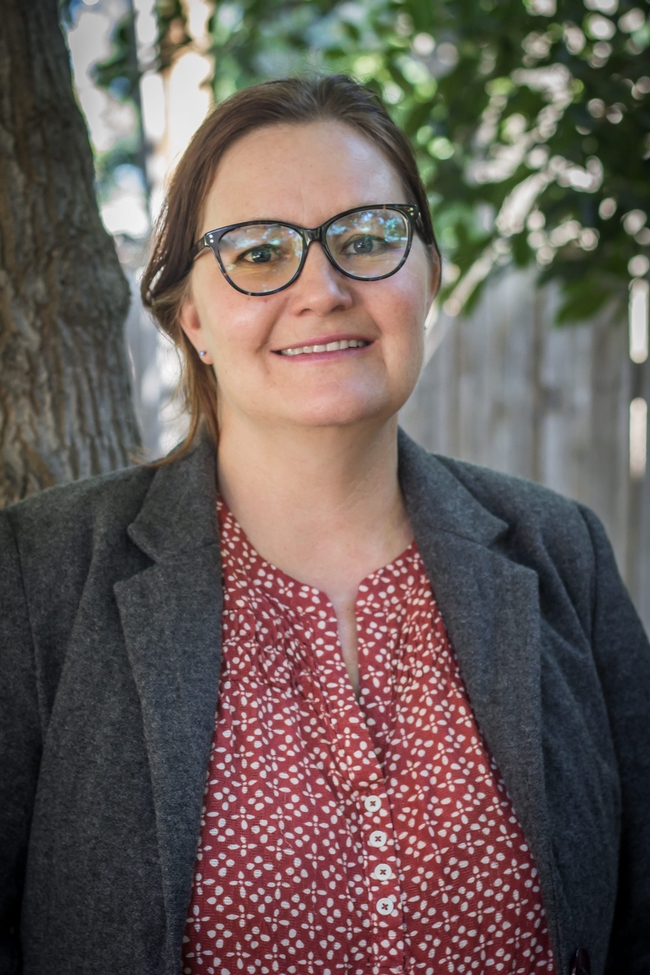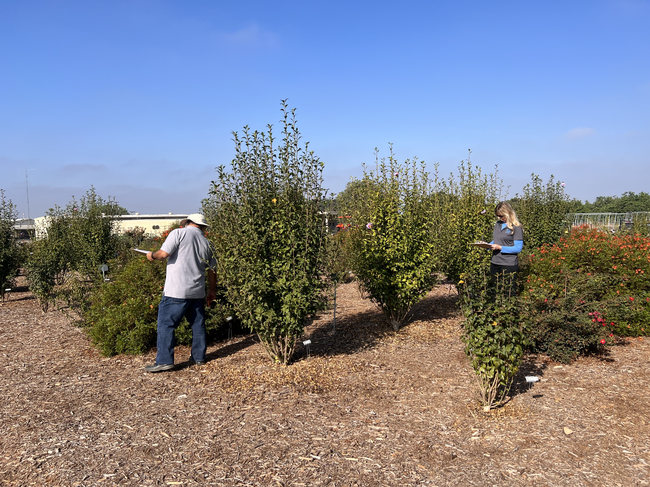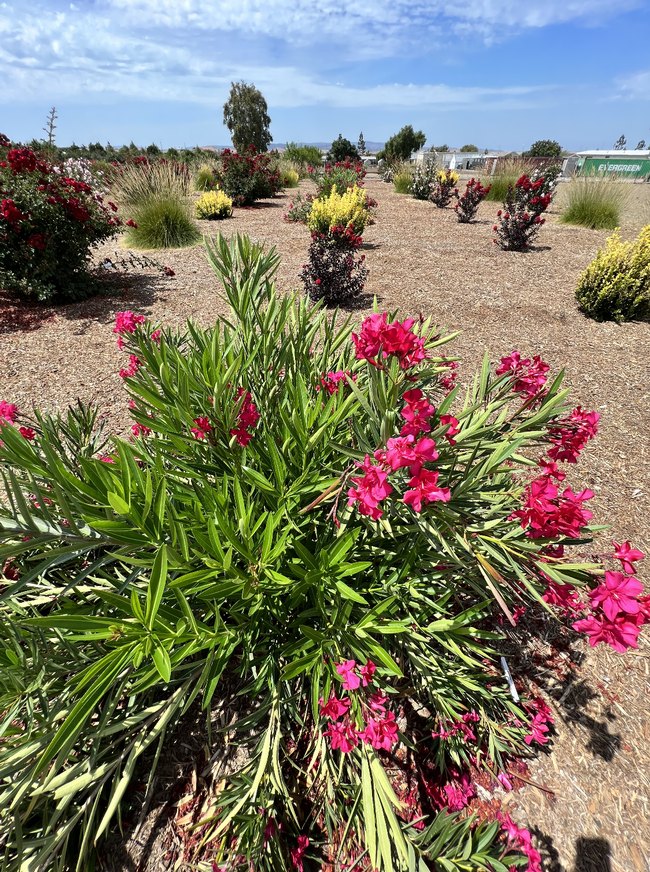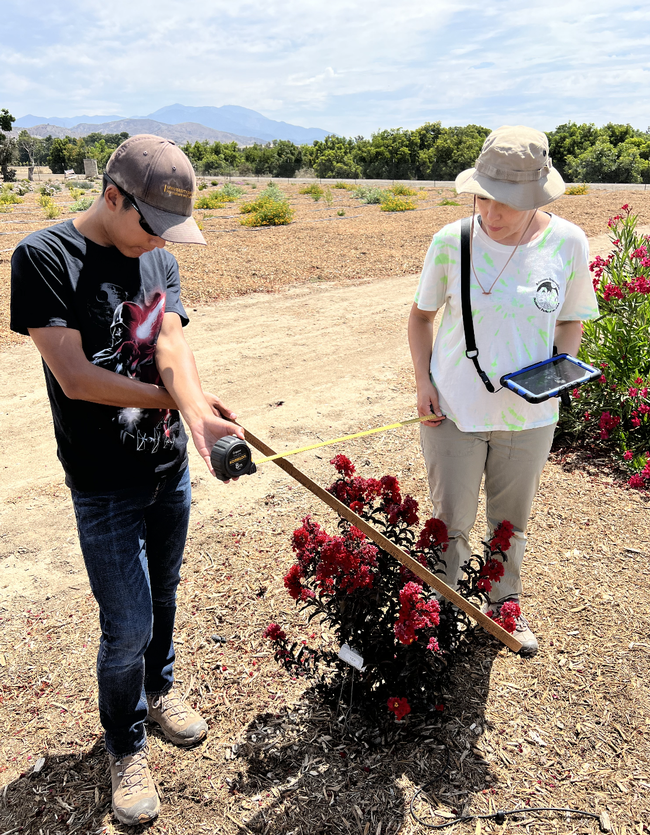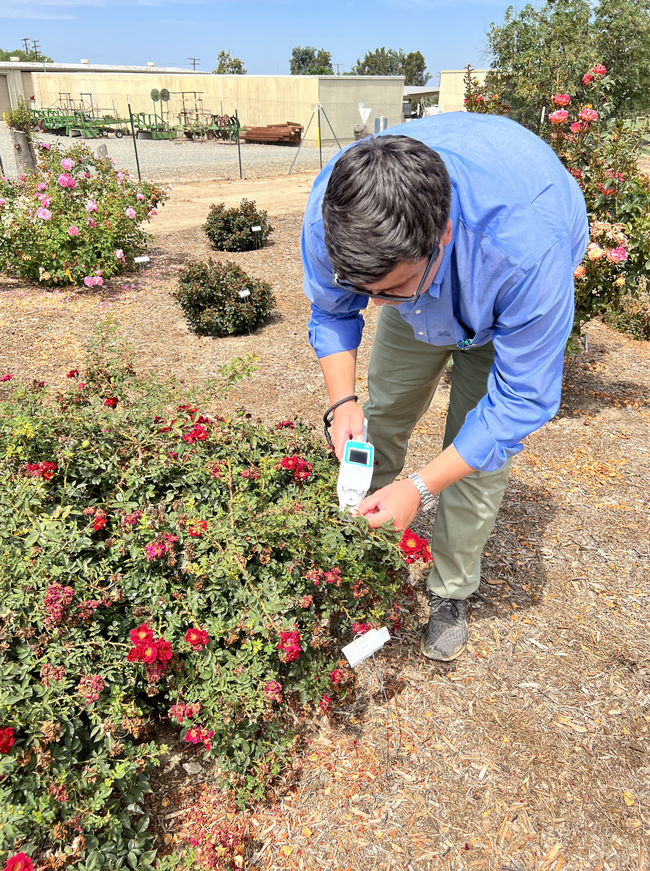Posts Tagged: Grant Johnson
Lawn-pocalypse! Surviving Drought
Ah, summer! The season of sunburns, pool parties, and… lawn droughts. If your once lush, green carpet now looks like a crunchy brown doormat, you're not alone. Let's dive into why your yard is staging a dramatic death scene and what you can do to...

Bermuda grass and weeds overtaking drought stressed turf grass.
New UC ANR scientists bring expertise in ag tech as well as crop production
This spring more scientists joined University of California Agriculture and Natural Resources to share their practical knowledge in counties across the state. UC ANR recently hired UC Cooperative Extension advisors and academic coordinators who bring expertise in small-scale farms, tree and field crops, water resiliency, weed management and pest management. In a sign of our changing times, UC Cooperative Extension added an urban agriculture technology area advisor.
UC Cooperative Extension advisors work directly with community members to apply research-based information to improve the lives and livelihoods of Californians. Increased funding from Gov. Gavin Newsom and the state Legislature has enabled UC ANR to expand its expertise across the state.
To see a list of UC Cooperative Extension advisors who have joined in the past few months, visit https://ucanr.edu/About/DirectorySearch/Recent_Hires. The most recently hired scientists are introduced below.
Wheeler-Dykes returns to roots with tree crops, weeds
For Becky Wheeler-Dykes, the UC Cooperative Extension orchard systems and weed ecology advisor for Glenn, Tehama and Colusa counties, her new position is deeply rooted in her background.
“I was born and raised on a small prune and walnut farm in Gridley, in nearby Butte County, and am very excited to be putting down roots close to family,” said Wheeler-Dykes, who started in this role on June 1.
Covering olives, prunes, walnuts and almonds, with an emphasis on weed management research in those cropping systems, Wheeler-Dykes is spending her first months on the job getting to know the region's growers and broader agricultural community.
“I hope to form great relationships with the clientele in my counties, providing a resource that they can trust and rely on,” she said. “I want to serve as an advocate for our region in developing research and finding answers for the unique systems we have here. My interests are alternative weed management in orchard systems and canopy management, but I look forward to hearing what other areas need to be addressed.”
After earning both a bachelor's in crop science and business management and a master's in entomology (with a focus on integrated pest management in tree crops) from UC Davis, Wheeler-Dykes has conducted extensive agricultural research.
“I'm excited to bring those experiences to the Sac Valley as the newest advisor,” she said, encouraging growers and producers in the region to contact her with the challenges they are facing.
Based at the UCCE Glenn County office in Orland, Wheeler-Dykes can be reached at bawheeler@ucanr.edu.
Castiaux expands role with Small Farms and Specialty Crops Program
Marianna Castiaux began her new role on June 1 as the Small Farms and Specialty Crops Program academic coordinator serving Californians statewide. In this role, Castiaux will be focused on improving workshops across all grants, creating new curriculum and teaching staff in other counties.
Aiming to build capacity to address growing challenges across California agriculture, she is excited to continue with the Small Farms and Specialty Crops Program in Fresno, where she has been working for the last three years as a project manager for the Healthy Soils Program.
Castiaux earned a Master of Science in conservation leadership from Colorado State University and a bachelor's degree in ecology and evolutionary biology from UC Santa Cruz. She has eight years of practical cross-cultural experience in agriculture, teaching and implementing climate-smart agricultural practices and summarizing complex topics in a more simplified form to various diverse audiences.
Fluent in Spanish, Castiaux was a bilingual lead educator for community-based participatory climate change resiliency programs for sugar cane farmers in Paraguay and coffee farmers in Mexico. She also worked with the California Strawberry Commission as a grower education specialist for three years teaching farmworkers and growers food safety, practices and research.
Castiaux is based in Fresno County and is best reached by email at mjcastiaux@ucanr.edu.
Angeles brings weed expertise to San Joaquin Valley
Jorge Angeles started on May 8 as the UC Cooperative Extension weed management and ecology advisor for Tulare, Kings and Fresno counties. Angeles will be right at home – in place and in vocation.
“I was born and raised in Tulare County and have been working in agriculture my entire life,” he said.
After receiving his bachelor's degree in plant science from Fresno State, Angeles conducted pesticide efficacy trials at the DuPont Research Farm in Madera. He later earned a master's in plant science from Fresno State, writing his thesis under the supervision of weed science professor Anil Shrestha and retired UCCE advisor Kurt Hembree.
An employee of UCCE for the past six years, Angeles worked with a pair of emeritus UCCE academics, Steve Wright and Bob Hutmacher.
Currently, Angeles is talking with growers, pest control advisers and other farm advisors about the pressing weed-management issues across the region.
“One of my main goals is to find alternative control methods for some of the herbicide-resistant and invasive weeds that are a problem in different agricultural crops,” he said.
Based in Tulare, Angeles can be reached at jaangeles@ucanr.edu and (559) 684-3300.
Johnson joins UC ANR as urban ag tech advisor
Grant Johnson joined UC ANR on May 1 as the UC Cooperative Extension urban agriculture technology area advisor for Los Angeles and Orange counties.
Johnson provides unbiased, research-driven information to people working in urban agriculture, with a focus on controlled environments such as greenhouses. His clientele is interested in adopting technologies that can improve plant production, ranging from nurseries and commercial growers to community members managing local gardens.
In his newly created role, Johnson's efforts will influence the scope of work for urban agricultural technology advisors to come. One of the challenges that he anticipates is “focusing knowledge” or choosing a specific problem to prioritize.
“I'm really interested in irrigation, soil and plant culture. There's a lot to consider and there's a lot that can be done,” said Johnson.
Before he was hired as an advisor, Johnson worked as a staff research associate for five years at the South Coast Research and Extension Center in Irvine under Darren Haver, director of UC ANR's Research and Extension Center system.
“I learned a lot while I was an SRA, but there was only so much that I could do. I wanted more freedom to explore as a researcher, so I decided I wanted to become an advisor,” Johnson said, adding that his career goal inspired him to return to school.
Johnson earned a master's degree in horticulture and agronomy from UC Davis, as well as a bachelor's degree in biology from Cal Poly San Luis Obispo.
One of the exciting aspects of the job, according to Johnson, is the ability to get creative and explore new territory. “I have some fun research interests, like how to grow wasabi or maximize saffron production using hydroponics,” Johnson explained.
“I'm interested in the kind of things that might be culturally important or significant to certain communities, and how they can be made more affordable and accessible,” he added.
Johnson is based out of the UC South Coast Research and Extension Center and can be reached at gejohnson@ucanr.edu.
Cohen joins UCCE as entomology advisor in Ventura County
Hamutahl Cohen joined UC ANR as a UC Cooperative Extension entomology advisor in Ventura County on June 1. Her primary responsibility is to develop environmentally sustainable pest management in local agricultural systems.
Cohen earned her Ph.D. from UC Santa Cruz, where she studied how to develop agricultural practices to promote a diversity of beneficial insects and ecosystem services. She then conducted postdoctoral research at UC Riverside, where she studied pollinator health in Yolo County sunflowers.
Her research has been presented at national and international conferences, published in more than 14 peer-reviewed publications, and shared through blogs, fact sheets and field days with her local grower community.
Prior to joining UC ANR, Cohen worked as a commercial horticulture agent with the Institute for Food and Agricultural Sciences at the University of Florida. This summer she will work with industry and university partners across Ventura County to evaluate the needs of the local growers and design an applied research and extension program.
Cohen is excited to address a myriad of issues related to pest management, including identification and monitoring, pest biology and phenology, crop loss assessment, pesticide resistance prevention, and evaluation of integrated pest management methods with an emphasis on biological and cultural controls. She is eager to conduct this work in regional crops such as berries, avocado, citrus and more.
“Ventura County is an important place to advance agricultural practices that reduce economic damage from pests while minimizing impacts on the environment, farmworkers and consumers,” said Cohen.
Cohen is based out of the UCCE office in Ventura and can be reached at hcohen@ucanr.edu. Follow her on Instagram @beescientista.
Tang joins UCCE in Napa County to work on water issues
Qicheng Tang joined UC Cooperative Extension in Napa County on April 10 as an assistant project scientist for water resources and water resiliency.
Tang will be developing water resiliency strategies for stakeholders and diverse ecosystems across Napa County. In addition, he will design and implement creative research, acquire and share technical knowledge, and promote stewardship of surface and groundwater resources to meet the needs of competing users and natural systems.
This summer, Tang will collaborate with growers, UC Davis researchers and UC ANR colleagues to measure the crop coefficient of Napa grape vineyards.
“This work aims to support groundwater sustainability planning with water budget calculations and to provide crucial information for irrigation management,” he said.
Prior to joining UC ANR, Tang earned a Ph.D. in soil science from Pennsylvania State University, where his work focused on the ecohydrology of oak-maple forest. Fluent in Mandarin, he also holds a bachelor's degree in hydrogeology from Nanjing University in China. Tang took a one-year training at North Carolina State University as a postdoctoral scholar working on large-scale nutrient modeling.
He Is looking forward to applying his experience and learning new skills in his new role.
“I am very excited about this new journey,” said Tang. “Water problems are pressing, important and interesting.”
Tang is based at the UCCE office in Napa and can be reached at qictang@ucanr.edu, LinkedIn and on Twitter @qicheng_tang.
Galdi named UCCE farm advisor in Merced County
Giuliano Galdi joined UC Cooperative Extension in Merced County on May 1 as an agronomy and crops advisor. In Merced, he will be working with alfalfa, corn, cotton, and small grain crops as well as helping with weed management and other issues related to crop production.
He had served as a UC Cooperative Extension agronomy advisor in Siskiyou County since 2019.
While in Siskiyou County, he worked on managing blue alfalfa aphids and investigating crop injury to Roundup Ready alfalfa with Rob Wilson, director of Intermountain Research and Extension Center and UCCE in Siskiyou County, and Tom Getts, UCCE weed and crop systems advisor for Lassen County. Galdi also conducted research on irrigation efficiency, winter groundwater recharge, and soil moisture sensors.
Prior to joining UCCE, Galdi was a junior specialist at UC Davis, where he worked on a variety of field trials, mainly alfalfa and forage crops, with the objective of improving the sustainability of water use and hay quality. As a master's student and student research assistant at Fresno State, Galdi evaluated salinity tolerance in different alfalfa varieties. He speaks Portuguese fluently.
Galdi earned a M.S. in plant sciences from Fresno State and a B.S. in agronomy engineering from University of Sao Paulo, Brazil.
Galdi is based in Merced and can be reached at gcgaldi@ucanr.edu.
Reyes joins UCCE as orchard systems advisor
Clarissa Reyes joined UC Cooperative Extension on March 1 as an orchard systems advisor. Her role focuses on walnut, cling peach and kiwifruit production in Sutter, Yuba, Butte and Placer counties. Reyes serves as a point of contact for orchard owners when they need support diagnosing and solving problems.
Reyes is excited about developing climate-adapted management practices and working with the recently expanded team of orchard advisors serving the northern Sacramento Valley, but she also anticipates encountering some challenges.
“Some of the challenges I expect to face are low crop prices despite increasing costs to farmers, including labor and inputs; water scarcity; and more frequent and higher temperature heat waves affecting fruit development and quality,” explained Reyes.
Reyes earned a master's degree in horticulture and agronomy from UC Davis. She also earned a bachelor's degree in biology from UC San Diego.
When describing her journey into agriculture, Reyes said that she “likes the way food makes it easy to connect with people.” She also said that after realizing a career in biotech was “not a good fit,” she let her love for gardening alter her career path.
“I'm really into food systems and food is an important part of culture,” said Reyes. “So, it was the overlap of research and food. Even though the science part can go over someone's head, everyone understands food.”
Before joining Cooperative Extension, she worked as a junior specialist studying plant-water relations at UC Davis. While her research was focused on grapevines, she started working with walnut trees, which exposed her to opportunities in orchard systems. Afterwards, she became a staff research associate in orchards systems in Butte, Glenn and Tehama counties.
Reyes is based out of the UC Cooperative Extension office in Yuba City and can be reached at clareyes@ucanr.edu.
Climate-Change Resources
University of California UC ANR Green Blog (Climate Change and Other Topics) https://ucanr.edu/blogs/Green/index.cfm?tagname=climate%20change (full index)
Examples:
- Save Trees First: Tips to Keep Them Alive Under Drought https://ucanr.edu/b/~CdD
- Landscaping with Fire Exposure in Mind: https://ucanr.edu/b/~G4D
- Cities in California Inland Areas Must Make Street Tree Changes to adapt to Future Climate https://ucanr.edu/b/~oF7
Drought, Climate Change and California Water Management Ted Grantham, UC Cooperative Extension specialist (23 minutes) https://youtu.be/dlimj75Wn9Q
Climate Variability and Change: Trends and Impacts on CA Agriculture Tapan Pathak, UC Cooperative Extension specialist (24 minutes) https://youtu.be/bIHI0yqqQJc
California Institute for Water Resources (links to blogs, talks, podcasts, water experts, etc.) https://ciwr.ucanr.edu/California_Drought_Expertise/
UC ANR Wildfire Resources (publications, videos, etc.) https://ucanr.edu/News/For_the_media/Press_kits/Wildfire/ (main website)
-UC ANR Fire Resources and Information https://ucanr.edu/sites/fire/ (main website)
-Preparing Home Landscaping https://ucanr.edu/sites/fire/Prepare/Landscaping/
UC ANR Free Publications https://anrcatalog.ucanr.edu/ (main website)
- Benefits of Plants to Humans and Urban Ecosystems: https://anrcatalog.ucanr.edu/pdf/8726.pdf
-Keeping Plants Alive Under Drought and Water Restrictions (English version) https://anrcatalog.ucanr.edu/pdf/8553.pdf
(Spanish version) https://anrcatalog.ucanr.edu/pdf/8628.pdf
- Use of Graywater in Urban Landscapes https://anrcatalog.ucanr.edu/pdf/8536.pdf
- Sustainable Landscaping in California https://anrcatalog.ucanr.edu/pdf/8504.pdf
Other (Non-UC) Climate Change Resources
Urban Forests and Climate Change. Urban forests play an important role in climate change mitigation and adaptation. Active stewardship of a community's forestry assets can strengthen local resilience to climate change while creating more sustainable and desirable places to live. https://www.fs.usda.gov/ccrc/topics/urban-forests
Examining the Viability of Planting Trees to Mitigate Climate Change (plausible at the forest level) https://climate.nasa.gov/news/2927/examining-the-viability-of-planting-trees-to-help-mitigate-climate-change/
Reports and other information resources coordinated under the auspices of the United Nations and produced through the collaboration of thousands of international scientists to provide a clear and up to date view of the current state of scientific knowledge relevant to climate change. United Nations Climate Action
Scientific reports, programs, action movements and events related to climate change. National Center for Atmospheric Research (National Science Foundation)
Find useful reports, program information and other documents resulting from federally funded research and development into the behavior of the atmosphere and related physical, biological and social systems. Search and find climate data from prehistory through to an hour ago in the world's largest climate data archive. (Formerly the "Climatic Data Center") National Centers for Environmental Information (NOAA)
Think tank providing information, analysis, policy and solution development for addressing climate change and energy issues (formerly known as the: "Pew Center on Global Climate Change"). Center for Climate & Energy Solutions (C2ES)
Mapping Resilience: A Blueprint for Thriving in the Face of Climate Disaster. The Climate Adaptation Knowledge Exchange (CAKE) was launched in July 2010 and is managed by EcoAdapt, a non-profit with a singular mission: to create a robust future in the face of climate change by bringing together diverse players to reshape planning and management in response to rapid climate change. https://www.cakex.org/documents/mapping-resilience-blueprint-thriving-face-climate-disaster
Cal-Adapt provides a way to explore peer-reviewed data that portrays how climate change might affect California at the state and local level. We make this data available through downloads, visualizations, and the Cal-Adapt API for your research, outreach, and adaptation planning needs. Cal-Adapt is a collaboration between state agency funding programs, university and private sector researchers https://cal-adapt.org/
Find reports, maps, data and other resources produced through a confederation of the research arms of 13 Federal departments and agencies that carry out research and develop and maintain capabilities that support the Nation's response to global change. Global Change (U.S. Global Change Research Program)
The Pacific Institute is a global water think tank that combines science-based thought leadership with active outreach to influence local, national, and international efforts to develop sustainable water policies. https://pacinst.org/our-approach/
Making equity real in climate adaptation and community resilience policies and programs: a guidebook. https://greenlining.org/publications/2019/making-equity-real-in-climate-adaption-and-community-resilience-policies-and-programs-a-guidebook/
Quarterly CA Climate Updates and CA Drought Monitor Maps (updated each Thursday) https://www.drought.gov/documents/quarterly-climate-impacts-and-outlook-western-region-june-2022
Drought focus of Water Resources IMPACT magazine special issue
UC ANR experts address emotional toll of drought
Preparing the American West for prolonged drought is the focus of a double issue of Water Resources IMPACT magazine. The California Water Commission staff are guest editors for this special open-access edition of the magazine, which is published by the American Water Resources Association.
Faith Kearns, academic coordinator of University of California Agriculture and Natural Resources' California Institute for Water Resources, is among the authors delving into how drought impacts people and the environment and how we can better prepare for the inevitable.
The first issue, published on Feb. 14, focuses on water scarcity issues confronting California and the ways these issues affect different sectors.
In “Trauma, Care, and Solidarity: Addressing the Emotional Toll of Chronic Drought,” Kearns highlights the effects of drought on mental health. She points to the spike in suicide hotline calls when wells ran dry in Southeast Asian communities in California's Central Valley.
By listening to Southeast Asian farmers, Ruth Dahlquist-Willard and Michael Yang of UC Cooperative Extension were able to “lighten the load” for them by providing pragmatic support, Kearns writes.
“The scale of some of these highly emotional issues – drought, wildfires, climate change – can make them seem incredibly difficult, if not impossible, to deal with,” Kearns said. “At the same time, they are affecting everyone living in the western U.S. on a daily basis. I wanted to highlight and provide models based on work that people – whether they are researchers, clinical psychologists, or Cooperative Extension advisors – are doing right now to ease the way.”
The authors who contributed to the double issue are a diverse array of Tribal experts, academics, nongovernmental organization thought-leaders, water managers and water policy influencers, each of whom brings their own perspective on the topic of drought. Their expertise and perspectives in climate science, water policy and water management will help inform drought-related decision-making and support policies that better prepare the state to thrive during periods of prolonged water scarcity.
In addition to Kearns, the first issue includes articles contributed by:
- Samantha Stevenson, University of California, Santa Barbara
- Jay Lund, University of California, Davis
- Ron Goode, North Fork Mono Tribe
- Andy Fecko, Placer County Water Agency
- Jeff Mount, Public Policy Institute of California, and Ted Grantham, University of California, Berkeley/UC Cooperative Extension
- Nat Seavy and Karyn Stockdale, National Audubon Society
- Kjia Rivers, Community Water Center
- Cannon Michael, Bowles Farming
- Michelle Reimers, Turlock Irrigation District
The January/February edition of Water Resources IMPACT magazine can be accessed, free of charge, on the American Water Resources Association website at https://www.awra.org under “Publications.”
The second issue, to be published in March, will focus on drought response, considering the options for adaptation. This two-part series complements the Commission's work on strategies to protect communities and fish and wildlife in the event of a long-term drought.
Your water-efficient landscape doesn’t have to be barren
UC climate-ready landscape trials identify low-water yet attractive plants
Good news: roses can be a part of your water-efficient landscape. Lorence Oki, UC Cooperative Extension environmental horticulture specialist in the UC Davis Department of Plant Sciences, identified rose cultivars that remain aesthetically pleasing with little water.
Oki is the principal investigator of the Climate-Ready Landscape Plants project, which may be the largest irrigation trial in the western U.S., and the UC Plant Landscape Irrigation Trials (UCLPIT), the California component of that project. These projects evaluate landscape plants under varying irrigation levels to determine their optimal performance in regions requiring supplemental summer water.
“There are some assumptions that pretty plants use a lot of water, like roses,” Oki said. “Everyone thinks they need a lot of water, but we've found some that don't, and they still look great. A water-efficient landscape doesn't need to look like a Central Valley oak-grassland in the summer. It can look really attractive.”
In 2021, Oki's team at UC Davis identified Lomandra confertifolia ssp. pallida "Pom Pom" Shorty and Rosa "Sprogreatpink" Brick House® Pink as two of the best low-water plants in the trial.
“The useful tip or information that is shared at the end of each trial is the selection and designation of plants as Blue Ribbon winners. These are the plants that looked good with an overall rating of 4 or higher throughout and were on the low (20%) water treatment,” said Natalie Levy, associate specialist for water resources, who manages the project at the UC ANR South Coast Research and Extension Center.
How plants earn a blue ribbon
Each trial year, the selection of new plants is based on research recommendations and donated submissions from the nursery industry. The landscape plants are trialed in full sun or 50% shade cover.
Irrigation treatments are based on the rate of evaporation and plant transpiration (evapotranspiration) measured through a local California Irrigation Management Information System (CIMIS) weather station that provides a reference evapotranspiration (ETo) rate.
Three levels of irrigation are provided to the plants equal to 20%, 50%, and 80% of ETo. The volume of water applied is the same at each irrigation based on soil characteristics, but the interval between applications varies with weather and the treatment. Using this method, irrigations for the 20% treatment are less frequent than the 80% treatment.
“The 20% treatment during the 2022 trial was irrigated an average of once per month while the 80% treatment was irrigated weekly,” explained Levy.
During the deficit irrigation trial, monthly height and width measurements are taken to determine the plant growth index. Monthly qualitative aesthetic ratings on a scale of 1 to 5 are determined for foliage appearance, flowering abundance, pest tolerance, disease resistance, vigor and overall appearance.
A second round of flowering abundance and overall appearance measurements are also taken to capture more of the blooming period. For example, UCLPIT identified in the 2020 trial at South Coast REC that the "Apricot Drift" rose had a mean overall appearance score of 3.5 out of 5, deeming it “acceptable to very nice” and a low water use plant within the Water Use Classification of Landscape Species or WUCOLS guide.
Project expands options for landscape planting
“(WUCOLS) only has 3,500 plants in it. There are guesses that there are close to 10,000 cultivars in urban landscapes in California, if not more,” said Oki. “WUCOLS also didn't have numerical ratings. Instead, you'll see verbal ratings like ‘low water use' or ‘high water use.'”
The UCLPIT project has not only developed numerical recommendations for irrigation, but it has also added new landscape plants that are compliant with California's Model Water Efficient Landscape Ordinance. In fact, UCLPIT's data is one of the few sources that can be used to supplement WUCOLS.
Geographic diversity of trial sites adds to knowledge base
In addition to UC Davis and South Coast REC in Irvine, the trials have expanded beyond California as the Climate-Ready Landscape Plants project and is in progress at Oregon State University, University of Washington, University of Arizona and Utah State University thanks to a USDA/CDFA grant awarded in 2020.
Lloyd Nackley, associate professor of nursery production and greenhouse management at Oregon State University, is the principal investigator of the trial in the Portland metro area, which is entering its third year.
“People know that there are drought tolerant plants, but there are many. We're trying to highlight lesser known or newer varieties. And even though the trial is three years, most gardeners would hope that their garden lasts longer than that,” said Nackley.
One of the observations that Nackley recalls is of the Hibiscus Purple Pillar plant. Unlike the trial at South Coast, the Purple Pillar did not perform well in Oregon in the spring.
“It wasn't until August that we saw the plant bloom and begin to look like what we saw from South Coast in April,” Nackley said.
Ursula Schuch, horticulture professor and principal investigator of the trial taking place at the University of Arizona, was also surprised at the range of performance among different plant types and the effects of irrigation, heat and temperature.
“This research will reassure green industry professionals that they can stretch their water budget to successfully cultivate more plants, watering them according to their needs instead of irrigating every plant according to the highest water-using plants,” said Schuch.
Although research is only conducted in the West, the hope is that there will be trials in other regions of U.S.
Doing so would yield comprehensive information about the plants and their performance in different climates. As extreme weather events persist in the U.S., disease pressure and risks do too. Trials throughout the country would provide location-specific data regarding disease susceptibility.
To learn more about the UCLPIT research project, visit https://ucanr.edu/sites/UCLPIT/


